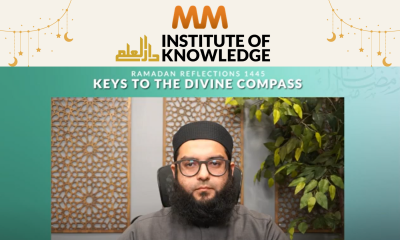Please read Part 1 and Part 2 before proceeding. Also there is a post on MM from a few months ago about best practices for youth outreach. Please contribute your ideas to that thread, especially if this series gives you some new inspirations :)
Another way the Prophet (saw) interacted with youth was by making them a center of the action – by involving them in whatever it was that he was doing.
Abdullah ibn Abbaas spent the night one day with his maternal aunt (Maymoonah) who was the wife of the Prophet (s). When the Prophet (s) got up, he checked to see if ibn Abbaas was asleep and then got up to pray Tahajjud. Ibn Abbas woke up and jumped to go and pray with him. He got up and went to pray with him and stood beside him on the left side. The Prophet(s) put his hand on his head and brought him around to his right side.
Normally we read this hadith in the context of the fiqhi rulings regarding how 2 people should stand when they are praying together and other such ahkaam. However, we again need to step back and look at it from the perspective of the child.
Keep supporting MuslimMatters for the sake of Allah
Alhamdulillah, we're at over 850 supporters. Help us get to 900 supporters this month. All it takes is a small gift from a reader like you to keep us going, for just $2 / month.
The Prophet (SAW) has taught us the best of deeds are those that done consistently, even if they are small.
Click here to support MuslimMatters with a monthly donation of $2 per month. Set it and collect blessings from Allah (swt) for the khayr you're supporting without thinking about it.
The Prophet (saw) made ibn Abbaas a central part of what he was doing. He made him a part of the action. This will leave a lasting impression on the young child. We should strive to involve our children in what we do.
While I’m not holding my breath waiting for all Muslim parents to all of a sudden start waking their 8 year olds up for tahajjud every day, there are practical things we can do to involve the youth. For example, give kids money, and let them donate it so that they learn about helping others. I remember praying juma once, and a man had given his son some money to put in the donation box. After seeing a couple of different slots, he went back to his dad yelling “Baba! Which box do I put the money it???!” Though the father was quite embarassed, it was still mashallah a good thing to see. It is amazing the types of little things that will make them feel excited – feel like they are doing something that adults do.
We have to create excitement for them. Give them their own special prayer rug, or maybe for girls they can sit with their mothers and design their own hijab that they can wear while praying. These are all small things that can be done to put kids in the mode of having a positive excitement about their deen.
If they do not get used to this from an early age, it will be many times more difficult later on in life. Parents complain about their teenagers not practicing, but what they don’t realize is that these ‘teenagers’ are already adults in the Islamic sense. They never put forth the effort to help their kids practice, and now they are confused why little Abdullah who wanted to go to medical school is now himself in need of methadone treatments.
Religion should not be something with a ‘you do this because you have to’ attitude – especially in America. Kids need to be taught why we are praying, why we are fasting. Teach them that fasting, for example, is to discipline yourself and grow closer to Allah, to see how poor people feel. They will appreciate it, and they will be more motivated to do it. More important than that though, is that parents themselves are not doing things like listening to music while fasting, or watching inappropriate things on television. This sends a mixed message to the child. The most glaring example of this is the many parents you find at Dhuhr time during Sunday School waiting outside for their kids to finish praying so they can pick them up.
It is time to reassess our family activities, the so-called ‘family time’ that we have. We should start doing things like studying Quran together as a family, attending conferences as a family, and many other activities that can be done.
To this point we have covered positive reinforcements, reward, and involvement of children as 3 examples of Prophetic methods of youth outreach. Some of them may seem a bit simple in nature, but we can never underestimate the lasting effects.
We can see the fruits from this Prophetic method in the following narration from the youth Anas (ra),
A man asked the Prophet about the Hour (i.e. Day of Judgment) saying, “When will the Hour be?” The Prophet said, “What have you prepared for it?” The man said, “Nothing, except that I love Allah and His Apostle.” The Prophet said, “You will be with those whom you love.” We had never been so happy as we were on hearing that saying of the Prophet (i.e., “You will be with those whom you love.”) Therefore, I love the Prophet, Abu Bakr and ‘Umar, and I hope that I will be with them because of my love for them though my deeds are not similar to theirs.
SubhanAllah. What more can be said? Where were they, and where are we?
A few weeks ago I heard a khutbah on a similar subject and the Imam was mentioning that our children now do not even know who the Sahabah are like Mu’adh bin Jabal, and other famous companions. He mentioned that it was a sad state that they don’t even know who they are, so how can they learn from their example? My wife mentioned to me that on the sisters side, when he said that, one sister said out loud, “So what? I don’t even know who those people are haha.” How do we expect the youth to know when the parents don’t?
May Allah (swt) guide us all. In part 4 we will discuss role models and insha’Allah conclude this series.












AnonyMouse
November 22, 2007 at 7:40 PM
One helpful tip for parents – if you read your child bedtime stories, try to tell them stories of the Prophets and the Sahaabah.
Don’t just read it out of a book in a monotone voice… make it lively, exciting, interesting!
Make the person seem “cool” – someone that your child will look up to, love, and try to emulate. Emphasize qualities such as love of Allah and His Messenger, dedication to ‘Ibaadah, courage, gentleness, nobility…
ibnabeeomar
November 25, 2007 at 9:24 PM
thats a good point and inshallah it will be touched upon more in part 4 when we discuss role models
Pingback: muslimmatters.org » The Youth Outreach Program of Muhammad (sal-Allahu ‘alayhi was-Sallam) Part 4